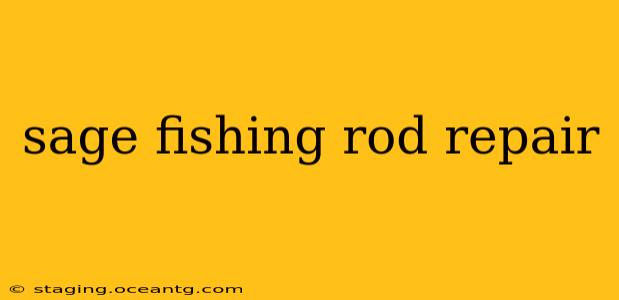Sage fly fishing rods are renowned for their quality and performance, but even the best equipment can suffer damage. Whether it's a broken tip, a cracked ferrule, or a damaged reel seat, knowing how to repair your Sage rod can save you money and keep you on the water. This guide covers common Sage rod repairs, offering advice for both DIY fixes and when professional help is necessary.
What are the most common Sage fly rod repairs?
This is perhaps the most frequently asked question regarding Sage rod maintenance. The most common repairs needed for Sage fly rods, like most high-end rods, include:
- Broken or Damaged Tip Sections: This is the most frequent type of damage, often caused by impacts with rocks, branches, or other obstacles. The severity ranges from minor chips to complete breakage.
- Cracked Ferrules: Ferrules, the connecting joints between rod sections, can crack due to excessive force or wear and tear. A cracked ferrule can significantly impact the rod's action and casting performance.
- Damaged Reel Seats: The reel seat, which holds the fishing reel, can become loose, stripped, or broken. This makes securing your reel difficult or impossible.
- Scratches and Cosmetic Damage: While not affecting performance, significant cosmetic damage can detract from the rod's appearance.
How can I repair a broken Sage fly rod tip?
Repairing a broken tip section often depends on the extent of the damage. Minor chips might be sanded down and finished, while a more significant break usually requires a replacement tip section. Finding a replacement is crucial. Contacting Sage directly or a reputable repair shop is the best approach to obtain a genuine replacement tip that matches your rod model. Attempting a DIY repair with epoxy and other materials on a substantial break is generally not recommended, as it can affect the rod's action and warranty.
Can I repair a cracked ferrule on my Sage rod myself?
Repairing a cracked ferrule is a more advanced repair and generally not recommended for beginners. It requires specialized tools and epoxy designed for rod repair. A poorly executed repair can lead to further damage. While some minor cracks might be temporarily stabilized with epoxy, the best course of action is usually to contact Sage or a professional rod repair shop. They have the experience and expertise to ensure a proper and lasting repair.
How do I fix a loose or damaged reel seat on my Sage rod?
A loose reel seat can be tightened if the problem is simply a loosened screw. However, if the threads are stripped or the seat itself is damaged, repair is more complex and often requires professional help. Attempting a DIY repair might worsen the situation. Again, contacting Sage or a qualified repair shop is the preferred method to address this issue.
How much does it typically cost to repair a Sage fishing rod?
The cost of repairing a Sage fly rod varies significantly depending on the type of damage and the extent of the repair. A simple tip repair might be relatively inexpensive, while a more complex repair, such as replacing a ferrule or reel seat, can be more costly. Always get a quote from the repair shop before proceeding. Factor in shipping costs if you're not local.
Where can I find a Sage rod repair shop near me?
Finding a qualified rod repair shop might require some research. Start by checking Sage's website, which might list authorized repair centers. You can also search online for "fly rod repair shops near me" and review their experience with high-end rods like Sage. Reading online reviews can give you insight into the quality of their work and customer service.
What is the warranty on Sage fishing rods?
Sage offers a warranty on its rods, though specifics vary depending on the model and the nature of the damage. Check Sage's website for their current warranty information. Understanding your warranty coverage is important before attempting any repairs yourself.
This comprehensive guide provides a solid starting point for understanding Sage fishing rod repair. Remember, preventing damage in the first place is always the best approach. Proper rod storage, careful handling, and understanding your rod's limitations are crucial for its longevity. When in doubt, consult a professional!
